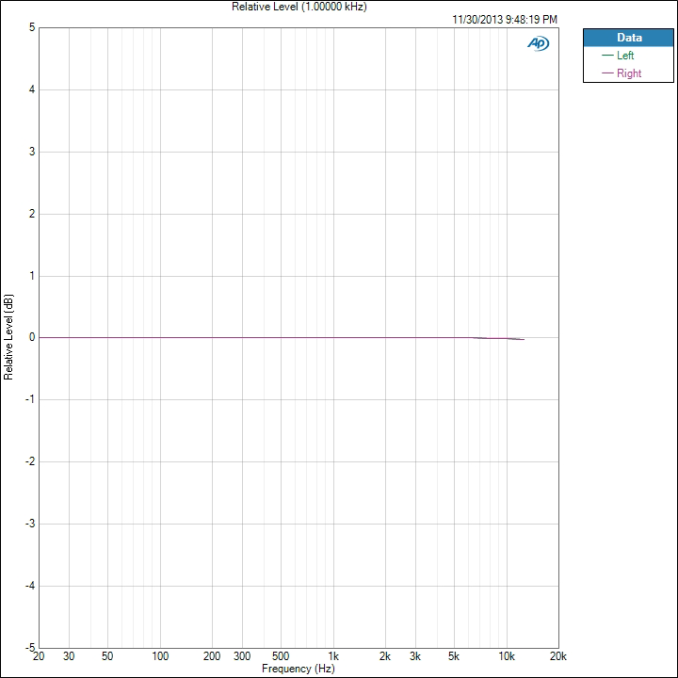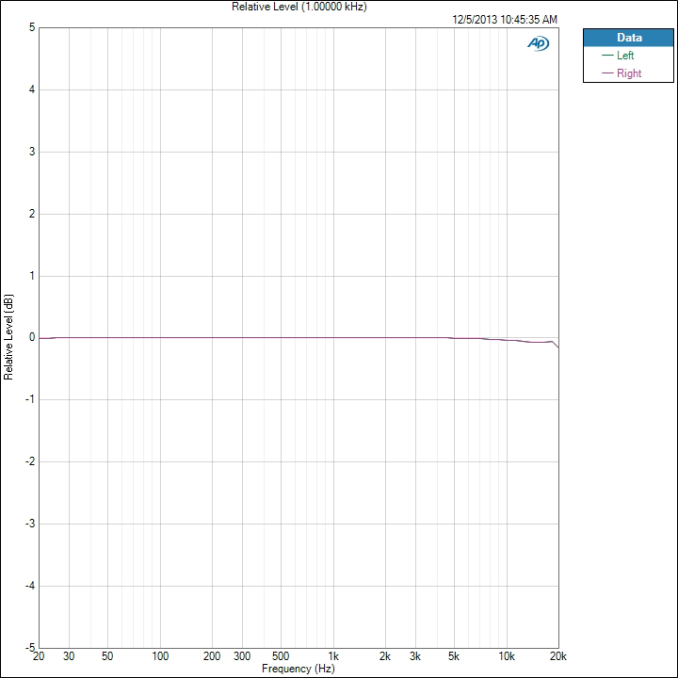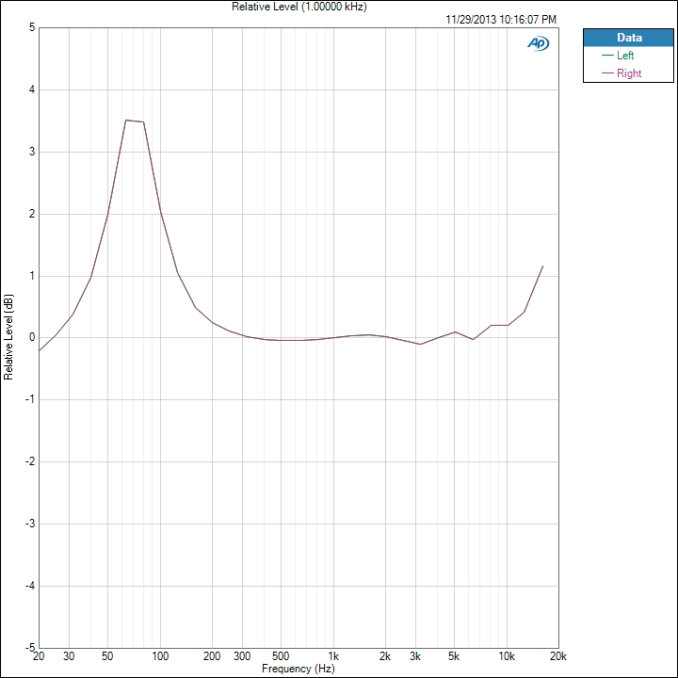Smartphone Audio Quality Testing
by Chris Heinonen on December 8, 2013 5:15 PM EST- Posted in
- Smartphones
- Audio
- Mobile
- Tablets
- Testing
Maximum Level
The maximum output level is derived from the 1kHz test tone used to determine THD+N. The higher the output from the headphone jack, the louder it can drive a pair of headphones. More importantly, having more power available means when you have dynamic music passages that call for power you are less likely to clip the waveform.
There is no chart to show here, just a number that the Audio Precision gives us. In our test data, the most powerful phone was the iPhone 5, at 32.46 mW of power. Next is the Nexus 5 at 22.24 mW, though we can’t drive it that high. Then the Note 3 at 11.81 mW and finally the Galaxy S4 at 3.895 mW. Doubling the power, from 4 mW to 8 mW, produces a 3 dB increase in volume level. 3 dB is the smallest change in volume levels we can easily hear. So even though the iPhone 5 produces 32 mW vs. 4 mW, that is only a 9 dB difference in volume. 10 dB is doubling the volume, so it isn’t even twice as loud. If you have demanding headphones, you will want as much power as you can get.
Frequency Response
To measure the frequency response we measure a set of 61 tones from 20 Hz to 20 kHz. All of these are then equalized to 1 kHz so we can see the maximum deviation from that level. An ideal phone will be perfectly flat here and allow you to adjust this with an EQ setting, or though your taste in headphones. On this test our best performing phone is the Galaxy S4, as seen here.
The total variation from 1 kHz is only 0.014 dB which is very good. The worst performing phone is the iPhone 5, but its variation is only 0.089 dB.
The iPhone 5 also picked up the 20 kHz tone while the Samsung and many others missed it. If we dropped this tone then it might be just as flat. The iPhone 5 test was run slightly differently, as it can't run the Android test program, which might account for this. For a phone with a different response, here is the HTC One with Beats enabled. Other HTC One testing is still in progress as I write this article.
Here we see that Beats is adding a +3.5 dB boost from 60 Hz to 90 Hz, but the deviation from 0 dB goes from 30Hz to 300 Hz. Past 6.5 kHz we also see a rise in the treble. People often mistake boosted treble for extra detail, which is likely the reasoning behind this. As we see it is far different than the other two examples we looked at.













188 Comments
View All Comments
Impulses - Monday, December 9, 2013 - link
Ehh, impedance curves for the headphones he suggested (Grado SR80, AKG K701) are easy to find (Inner Fidelity and others have decent databases)... Testing and providing output impedance for the phones would be very valuable indeed though, even if everything else in the chain performs alright that alone can affect the FR significantly with one pair of headphones and not at all with the next... And unfortunately there's never been a realistic standard for output impedance, (other than high quality solid state amps now aiming for >1 ohm), and it's often all over the place.ssddaydream - Monday, December 9, 2013 - link
I agree with this.I think of three main usage scenarios regarding the headphone output:
1.) Quality of HP output driving a high-impedance line-level input for a home or car stereo.
2.) Quality of HP output driving low-impedance, sensitive IEMs.
3.) Quality of HP output driving high-impedance, non-sensitive cans.
For #2 and #3, the output impedance should be known, as well as the amplifier power at a given THD level.
There reasons why the iPhones are able to perform well with IEMs, namely low noise floor and low output impedance. Also, iPhones perform well with larger cans because of the decent output power.
I think the usage cases I listed above are pretty common, so I think a good approach to testing is to think about the most important parameters for each usage case.
BTW, I am excited about AT doing these measurements- very good news, indeed!
Anand_user123 - Monday, December 9, 2013 - link
I use my phone most of the time as a music player. Audio quality and storage capacity for flac files are major factors in my buying decision. I hope we can have more widespread information on smartphones audio performancestepz - Monday, December 9, 2013 - link
If you actually cared about scientific measurements of audio performance you would use compressed audio instead of flac. ;) Given a decent amount of bitrate, compressed audio is indistinguishable from uncompressed in double blind tests. In my experience FLAC is mostly about the listener feeling good about getting the "correct" experience, like expensive speaker cables.Impulses - Monday, December 9, 2013 - link
There's a valid usage case for FLAC as far as ripping and archiving IMO, you might as well if you're ripping a large collection (or ripping often)... Since you can quickly re-transcode or edit files w/o a loss of quality... But yeah, I don't see why anyone would put FLAC files on a phone, transcoding is dead simple and super quick if you have a remotely modern PC. Managing FLAC & MP3 playlists or whatever shouldn't be a hurdle if you're putting the effort to maintain a FLAC library to begin with, just use the MP3 library for everything or use stuff like Media Monkey's smart filters/playlists.NaterGator - Monday, December 9, 2013 - link
The biasing of the amplifier in the Nexus 5 and LG G2 left channel appears incorrect. Note it is only clipping on the negative portion of the waveform.vshah - Monday, December 9, 2013 - link
Can't wait to see htc one results!jrs77 - Monday, December 9, 2013 - link
Could you compare the phones to an iPod maybe? This way we would've an comparisooon to a mediaplayer where there's no 3G/4G/LTE disturbance.Oh, and for the general audience discussing the DACs etc... The DAC isn't the cruicial part, never has been. The amp is what it's all about and how good or poor it's powered.
There's a reason why audiophiles still use tube-amps, or atleast digital amps with high quality toroidal transformers and good shielding to reduce noise distortion etc.
Oh, and btw... A good mediaplayer needs a microSDHC-slot or the possibility to use an USB-stick. A mediaplyer is no good if I can't carry my whole music-library with it (100+ GB).
Leezhunjin - Monday, December 9, 2013 - link
Hi Chris, very nice to see smartphones getting measured in terms of audio performance, as many of these phones are used as a music device as well. Personally, I think that an inclusion of output impedance measurements would really great be though, as it is one of the factors that would affect the earphone performance rather significantly.CSMR - Monday, December 9, 2013 - link
Very good start. Poor quality needs to be exposed and you've done this with the Nexus 5.I would like to see output impedance since low output impedance is a very important quality of a good headphone output.